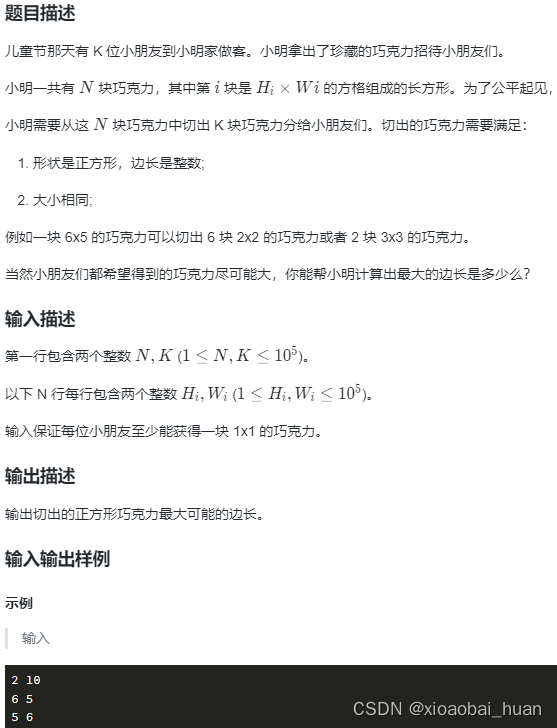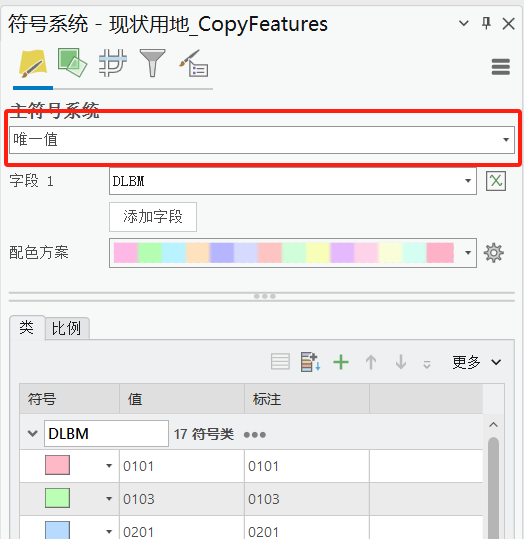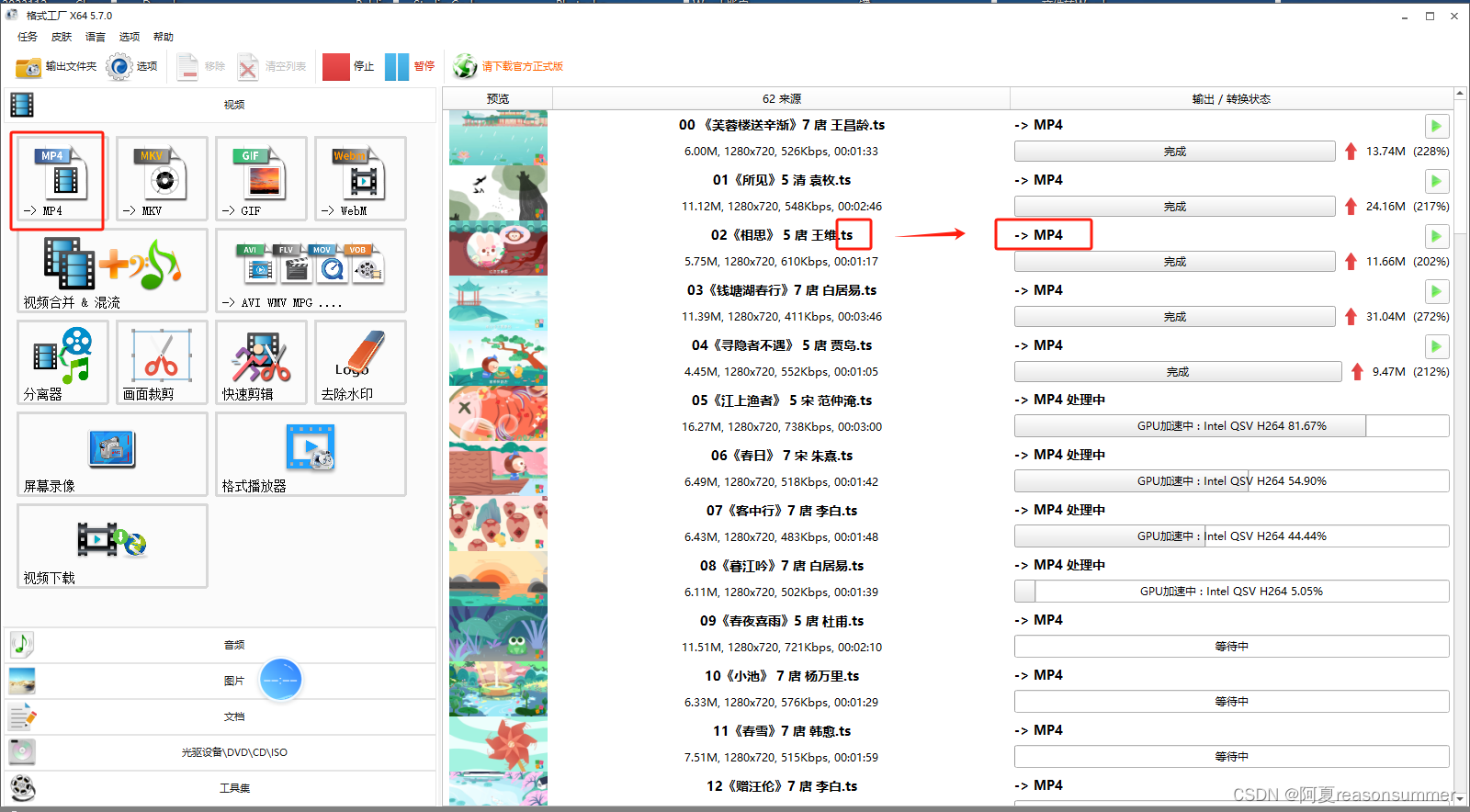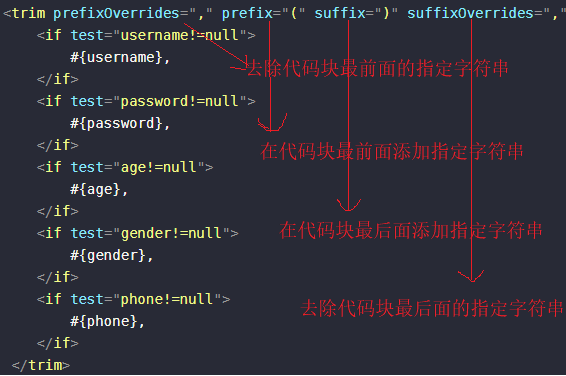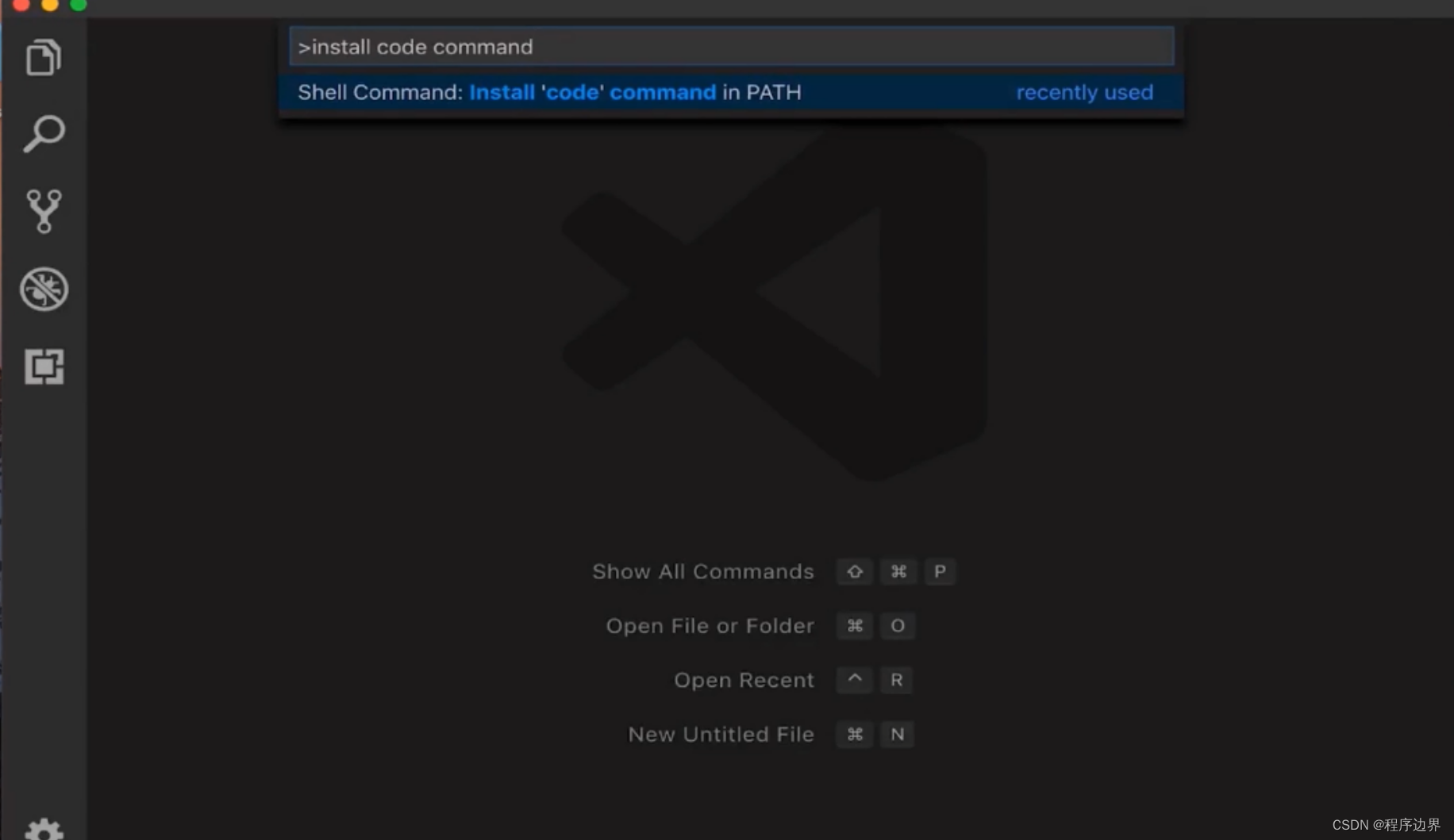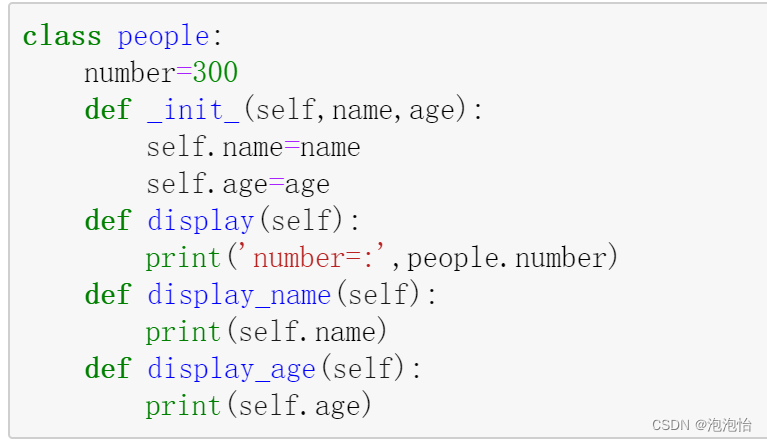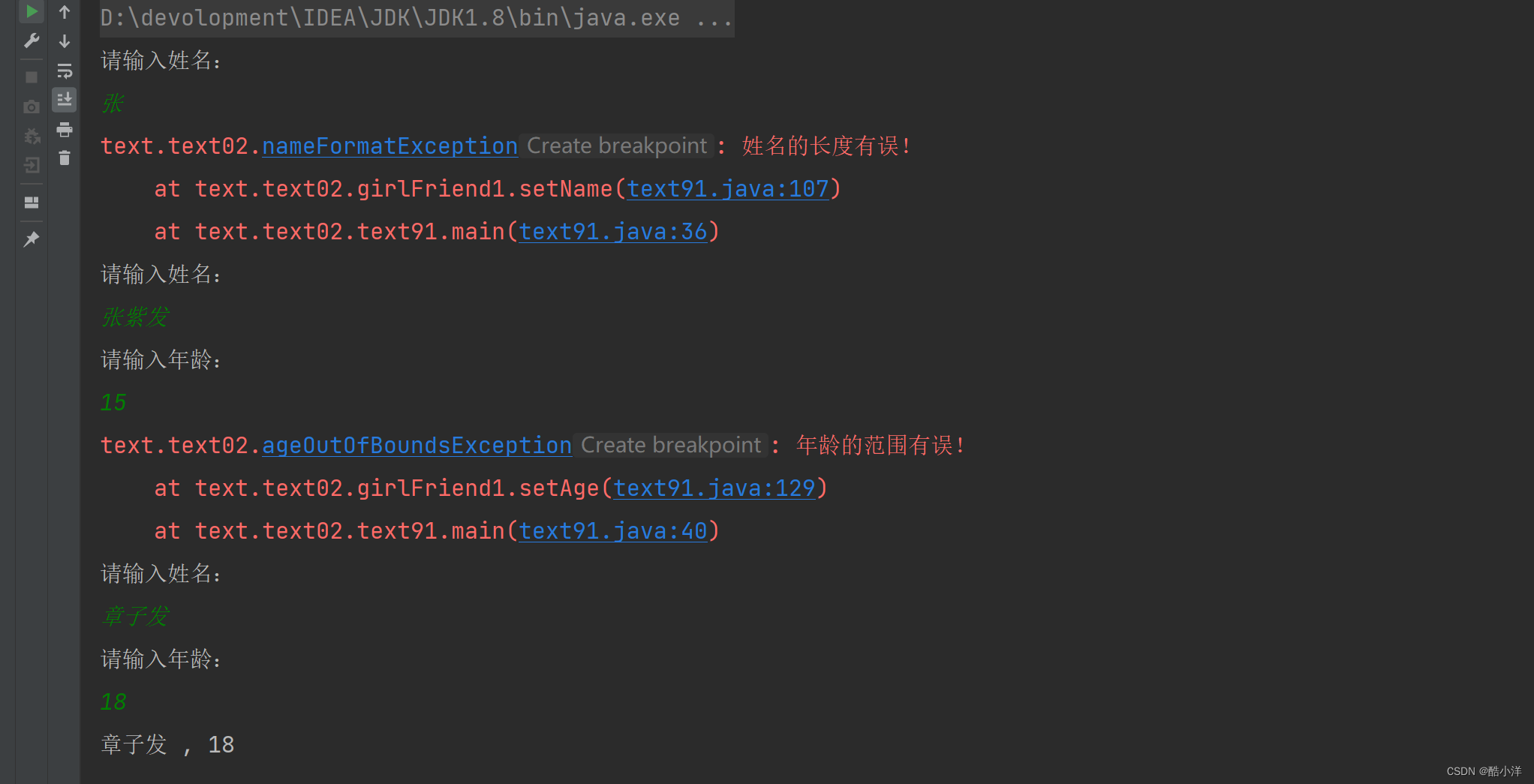文章目录
- 线程控制
线程控制
线程创建
代码:
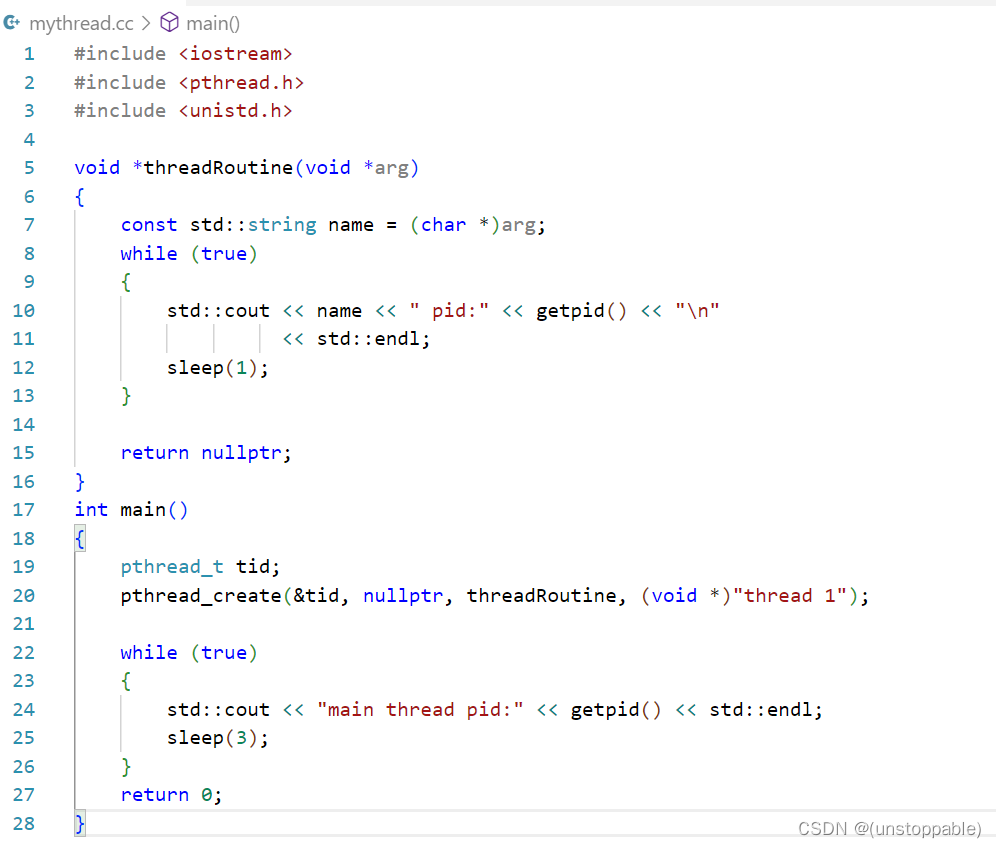
运行代码:
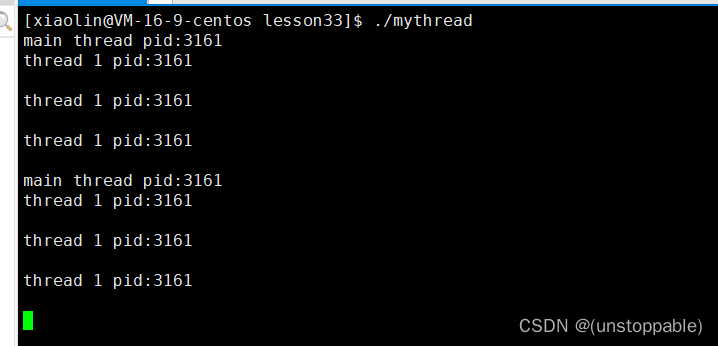
强调一点,线程和进程不一样,进程有父进程的概念,但在线程组里面,所有的线程都是对等关系。

错误检查:
- 传统的一些函数是,成功返回0,失败返回-1,并且对全局变量errno赋值以指示错误。
- pthreads函数出错时不会设置全局变量errno(而大部分其他POSIX函数会这样做)。而是将错误代码通过返回值返回
- pthreads同样也提供了线程内的errno变量,以支持其它使用errno的代码。对于pthreads函数的错误,建议通过返回值业判定,因为读取返回值要比读取线程内的errno变量的开销更小
进程ID和线程ID
在Linux中,目前的线程实现是Native POSIX Thread Libaray,简称NPTL。在这种实现下,线程又被称为轻量级进程(Light Weighted Process),每一个用户态的线程,在内核中都对应一个调度实体,也拥有自己的进程描述符(task_struct结构体)。
没有线程之前,一个进程对应内核里的一个进程描述符,对应一个进程ID。但是引入线程概念之后,情况发生了变化,一个用户进程下管辖N个用户态线程,每个线程作为一个独立的调度实体在内核态都有自己的进程描述符,进程和内核的描述符一下子就变成了1:N关系,POSIX标准又要求进程内的所有线程调用
getpid函数时返回相同的进程ID,如何解决上述问题呢?
Linux内核引入了线程组的概念。
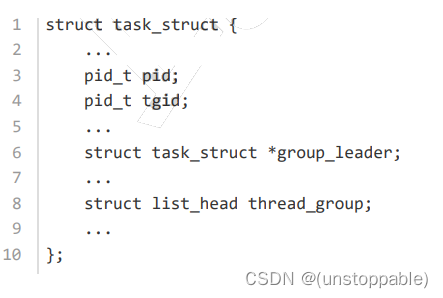
多线程的进程,又被称为线程组,线程组内的每一个线程在内核之中都存在一个进程描述符(task_struct)与之对应。进程描述符结构体中的pid,表面上看对应的是进程ID,其实不然,它对应的是线程ID;进程描述
符中的tgid,含义是Thread Group ID,该值对应的是用户层面的进程ID

线程异常
我们之前学到线程一旦异常那么整个进程都会退出,那么真的是如此吗?
演示:
代码
#include <iostream>
#include <pthread.h>
#include <unistd.h>
void *threadRoutine(void *arg)
{
const std::string name = (char *)arg;
while (true)
{
std::cout << name << " pid:" << getpid() << "\n"
<< std::endl;
int a = 100;
a /= 0;//除0错误
sleep(1);
}
return nullptr;
}
int main()
{
pthread_t tid;
pthread_create(&tid, nullptr, threadRoutine, (void *)"thread 1");
while (true)
{
std::cout << "main thread pid:" << getpid() << std::endl;
sleep(3);
}
return 0;
}
运行代码:
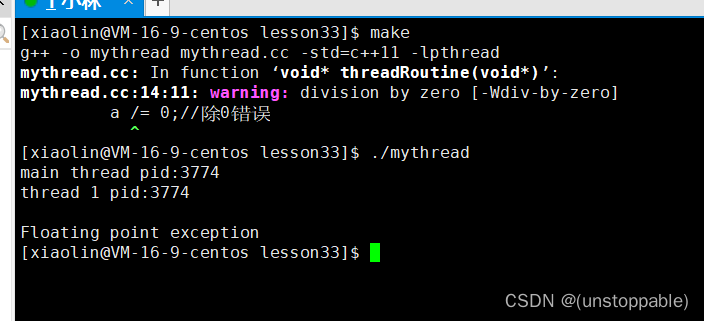
我们发现线程一旦异常确实会影响到整个进程。
结论:
1.线程谁先运行与调度器相关
2.随便哪个线程一旦异常,都可能导致整个进程整体退出
3.线程在创建并执行的时候,线程也需要进行等待的,如果主线程不等待,也会引起类似于僵尸进程问题,导致内存泄漏。
线程等待
已经退出的线程,其空间没有被释放,仍然在进程的地址空间内。
创建新的线程不会复用刚才退出线程的地址空间。
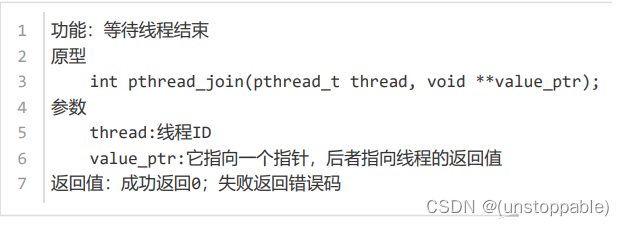
调用该函数的线程将挂起等待,直到id为thread的线程终止。thread线程以不同的方法终止,通过pthread_join得到的终止状态是不同的,总结如下:
- 如果thread线程通过return返回,value_ ptr所指向的单元里存放的是thread线程函数的返回值。
- 如果thread线程被别的线程调用pthread_ cancel异常终掉,value_ ptr所指向的单元里存放的是常数PTHREAD_CANCELED。
- 如果thread线程是自己调用pthread_exit终止的,value_ptr所指向的单元存放的是传给pthread_exit的参数。
- 如果对thread线程的终止状态不感兴趣,可以传NULL给value_ ptr参数。


参数解释:
thread:线程id
retval:输出型参数,下面再解释用处
pthread_join默认阻塞等待。
代码:
#include <iostream>
#include <pthread.h>
#include <unistd.h>
void *threadRoutine(void *arg)
{
const std::string name = (char *)arg;
int i = 0;
while (true)
{
std::cout << name << "runing....." << std::endl;
sleep(1);
if(i++ == 10)
{
break;
}
}
std::cout << "new thread quit....." << std::endl;
return nullptr;
}
int main()
{
pthread_t tid;
pthread_create(&tid, nullptr, threadRoutine, (void *)"thread 1");
pthread_join(tid,nullptr);
std::cout << "main thread wait done .... main quit!" << std::endl;
return 0;
}
运行代码:
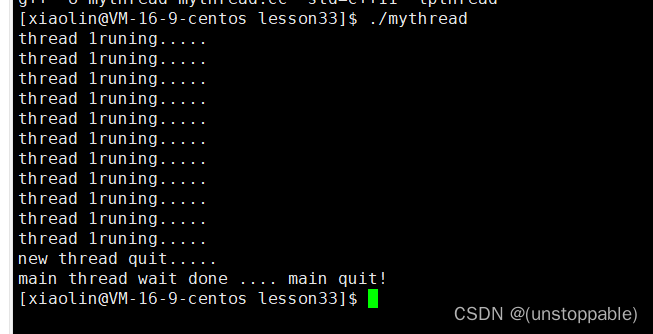
我们知道pthread_create里面有一个回调函数,而回调函数里面有一个返回值我们之前一直返回nullptr
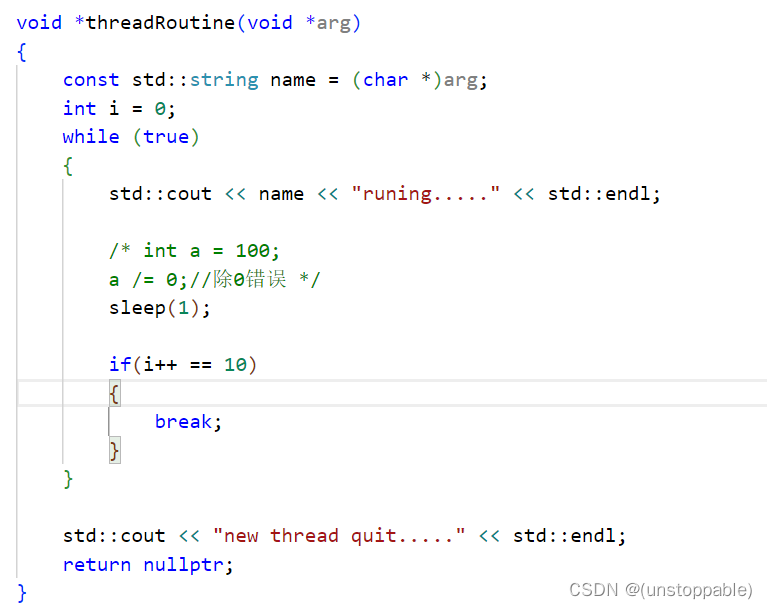
这个返回值,一般是给主线程的,那么主线程该如何获取到?用pthread_join。

pthread_join的第二个参数,是输出型参数,用来获取放回值的。
代码:
#include <iostream>
#include <pthread.h>
#include <unistd.h>
void *threadRoutine(void *arg)
{
const std::string name = (char *)arg;
int i = 0;
while (true)
{
std::cout << name << "runing....." << std::endl;
sleep(1);
if (i++ == 10)
{
break;
}
}
std::cout << "new thread quit....." << std::endl;
return (void *)10;
}
int main()
{
pthread_t tid;
pthread_create(&tid, nullptr, threadRoutine, (void *)"thread 1");
void *ret = nullptr;
pthread_join(tid, &ret);
std::cout << "ret: " << (long long)ret << std::endl;
std::cout << "main thread wait done .... main quit!" << std::endl;
return 0;
}
我们运行的时候会这样
我们只要在g++后面加-fpermissive即可
g++ -o mythread mythread.cc -std=c++11 -lpthread -fpermissive

再运行代码:
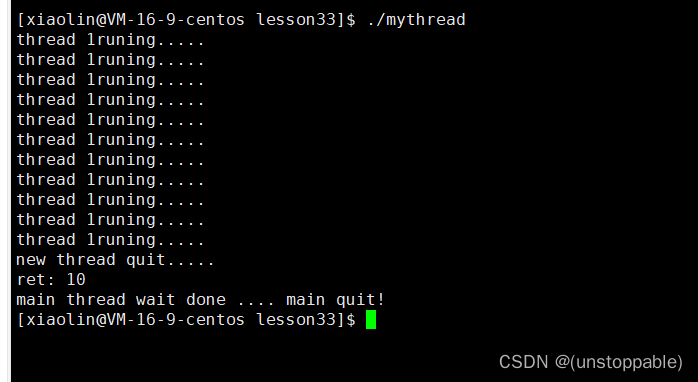
可以看到,我们成功获取到了返回值。
我们不仅仅只能返回变量,我们还能返回其它内容。
代码:
#include <iostream>
#include <pthread.h>
#include <unistd.h>
void *threadRoutine(void *arg)
{
const std::string name = (char *)arg;
int i = 0;
int *data = new int[10];
while (true)
{
std::cout << name << "runing....." << std::endl;
sleep(1);
data[i] = i;
if (i++ == 10)
{
break;
}
}
std::cout << "new thread quit....." << std::endl;
return (void *)data;
}
int main()
{
pthread_t tid;
pthread_create(&tid, nullptr, threadRoutine, (void *)"thread 1");
void *ret = nullptr;
pthread_join(tid, &ret);
int *data = (int *)ret;
for (int i = 0; i < 10; i++)
{
std::cout << data[i] << " ";
}
std::cout << std::endl;
std::cout << "main thread wait done .... main quit!" << std::endl;
return 0;
}
运行结果:
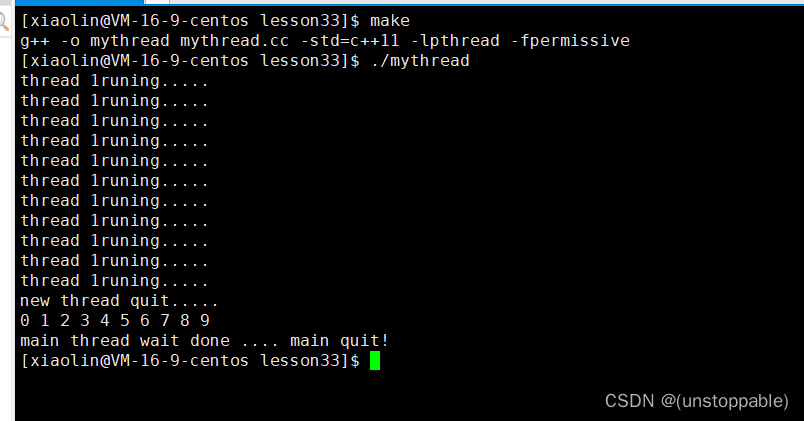
线程终止
如果需要只终止某个线程而不终止整个进程,可以有三种方法:
- 从线程函数return。这种方法对主线程不适用,从main函数return相当于调用exit。
- 线程可以调用pthread_ exit终止自己。
- 一个线程可以调用pthread_ cancel终止同一进程中的另一个线程。
能不能用exit终止线程呢?
代码:
#include <iostream>
#include <pthread.h>
#include <unistd.h>
void *threadRoutine(void *arg)
{
const std::string name = (char *)arg;
int i = 0;
int *data = new int[10];
while (true)
{
std::cout << name << "runing....." << std::endl;
sleep(1);
data[i] = i;
if (i++ == 10)
{
break;
}
}
std::cout << "new thread quit....." << std::endl;
exit(10);
return (void *)data;
}
int main()
{
pthread_t tid;
pthread_create(&tid, nullptr, threadRoutine, (void *)"thread 1");
void *ret = nullptr;
pthread_join(tid, &ret);
int *data = (int *)ret;
for (int i = 0; i < 10; i++)
{
std::cout << data[i] << " ";
}
std::cout << std::endl;
std::cout << "main thread wait done .... main quit!" << std::endl;
return 0;
}
运行结果:
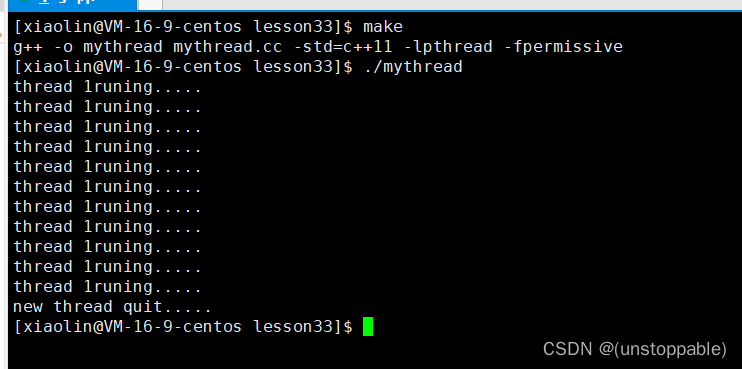
我们发现整个进程都被终止了,因为exit是终止进程的,绝对不要用exit终止线程。
那么我们如何终止新线程而不影响main线程呢?
pthread_exit()OS提供的终止线程的函数
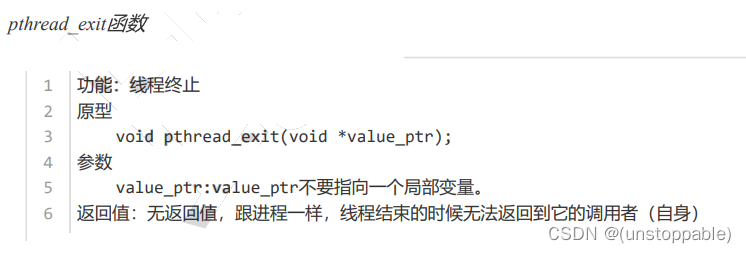

参数retval就是之前的返回值。
代码
#include <iostream>
#include <pthread.h>
#include <unistd.h>
void *threadRoutine(void *arg)
{
const std::string name = (char *)arg;
int i = 0;
int *data = new int[10];
while (true)
{
std::cout << name << "runing....." << std::endl;
sleep(1);
data[i] = i;
if (i++ == 10)
{
break;
}
}
std::cout << "new thread quit....." << std::endl;
pthread_exit((void*)data);
}
int main()
{
pthread_t tid;
pthread_create(&tid, nullptr, threadRoutine, (void *)"thread 1");
void *ret = nullptr;
pthread_join(tid, &ret);
int *data = (int *)ret;
for (int i = 0; i < 10; i++)
{
std::cout << data[i] << " ";
}
std::cout << std::endl;
std::cout << "main thread wait done .... main quit!" << std::endl;
return 0;
}
运行结果:
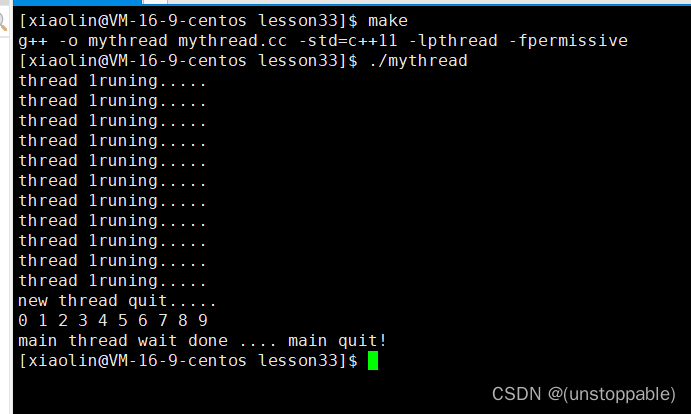
我们看到线程终止成功。
线程取消
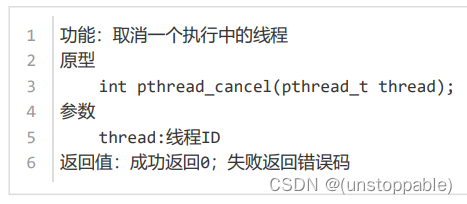
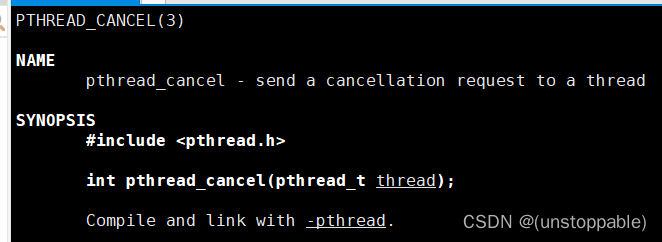

代码:
#include <iostream>
#include <pthread.h>
#include <unistd.h>
void *threadRoutine(void *arg)
{
const std::string name = (char *)arg;
while (true)
{
std::cout << name << "runing....." << std::endl;
sleep(1);
}
std::cout << "new thread quit....." << std::endl;
}
int main()
{
pthread_t tid;
pthread_create(&tid, nullptr, threadRoutine, (void *)"thread 1");
int count = 3;
while (true)
{
std::cout << "main thread pid:" << getpid() << std::endl;
if(count++ > 5) break;
sleep(2);
}
pthread_cancel(tid);
std::cout << "pthread cancle tid: " << tid << std::endl;
void *ret = nullptr;
pthread_join(tid, &ret);
std::cout << "ret: " << (long long)ret << std::endl;
std::cout << "main thread wait done .... main quit!" << std::endl;
sleep(5);
return 0;
}
运行结果:
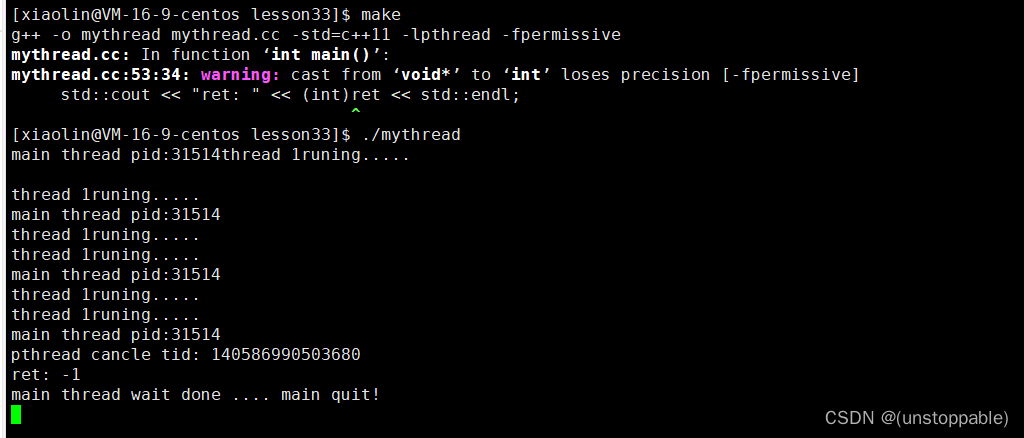
我们看到最后main线程确实等待了5秒
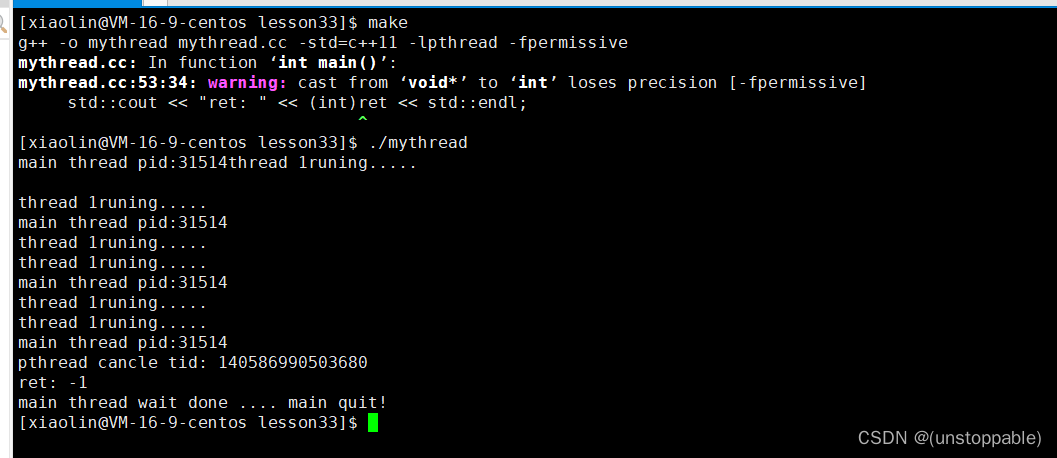
然后退出了。
我们看到其中tid为啥这么大呢?之后再讲解。
而我们看到线程被取消,我们join的时候,退出码是-1.
而-1其实是:

线程ID的探索
我们之前看到线程ID是一个很大的值
格式化输出线程ID:
代码:
#include <iostream>
#include <pthread.h>
#include <unistd.h>
#include <cstdio>
void *threadRoutine(void *arg)
{
const std::string name = (char *)arg;
while (true)
{
std::cout << name << "runing....." << std::endl;
sleep(1);
}
std::cout << "new thread quit....." << std::endl;
}
int main()
{
pthread_t tid;
pthread_create(&tid, nullptr, threadRoutine, (void *)"thread 1");
printf("%u,%p\n",tid,tid);
int count = 3;
while (true)
{
std::cout << "main thread pid:" << getpid() << std::endl;
if(count++ > 5) break;
sleep(2);
}
pthread_cancel(tid);
std::cout << "pthread cancle tid: " << tid << std::endl;
void *ret = nullptr;
pthread_join(tid, &ret);
std::cout << "ret: " << (long long)ret << std::endl;
std::cout << "main thread wait done .... main quit!" << std::endl;
sleep(5);
return 0;
}
运行结果:

我们看到线程ID值很大,tid的本质是一个地址。
为什么tid不用Linux中的LWP呢?
因为目前用的不是Linux自带的创建线程的接口,我们用的是pthread库中的接口。
我们知道线程共享进程的地址空间
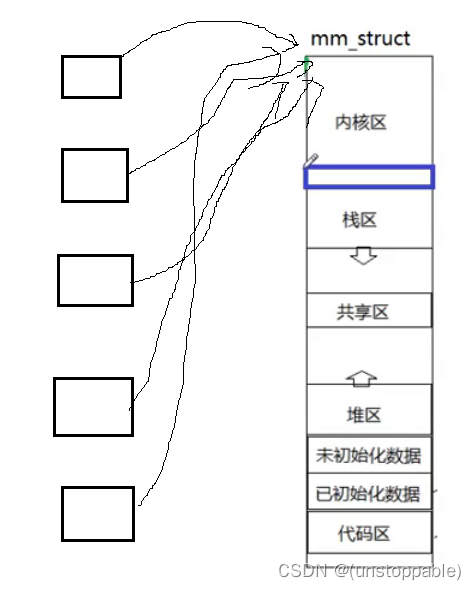
但是线程有自己独立的栈结构,那么如何保证栈区是每一个线程独占的呢?---->原本的栈给main线程使用,而其余线程把共享区当做栈区。所以每个线程的tid就是自己栈区的起始地址
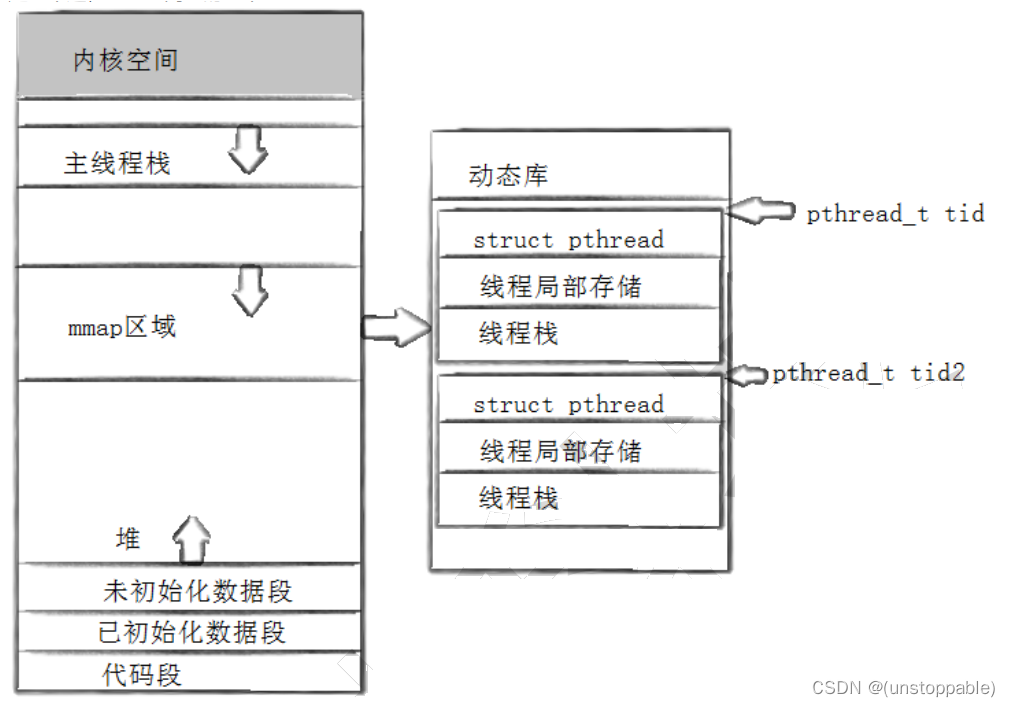
见一见

pthread库时通过clone做到上面的那点。

那么我们如何获取线程的id呢?

代码:
#include <iostream>
#include <pthread.h>
#include <unistd.h>
#include <cstdio>
void *threadRoutine(void *arg)
{
const std::string name = (char *)arg;
while (true)
{
std::cout << name << "runing..... id: " << pthread_self() << std::endl;
sleep(1);
}
std::cout << "new thread quit....." << std::endl;
}
int main()
{
pthread_t tid;
pthread_create(&tid, nullptr, threadRoutine, (void *)"thread 1");
int count = 3;
while (true)
{
std::cout << "main thread id:" << pthread_self() << std::endl;
if(count++ > 5) break;
sleep(2);
}
void *ret = nullptr;
pthread_join(tid, &ret);
std::cout << "ret: " << (long long)ret << std::endl;
std::cout << "main thread wait done .... main quit!" << std::endl;
sleep(5);
return 0;
}
运行代码:
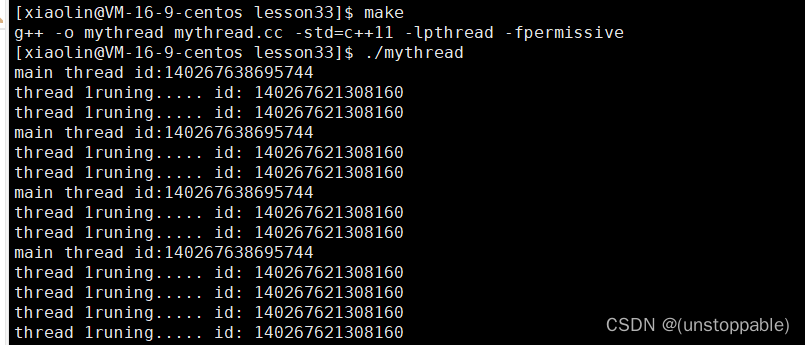
我们看到我们获取到了不同的线程id
大部分线程的代码是共享的!
一个小实验:
代码:
#include <iostream>
#include <pthread.h>
#include <unistd.h>
#include <cstdio>
int g_val = 0;
void *threadRoutine(void *arg)
{
const std::string name = (char *)arg;
while(true)
{
std::cout << name << " g_val: " << g_val << " &g_val" << &g_val << std::endl;
g_val++;
sleep(1);
}
}
int main()
{
pthread_t tid;
pthread_create(&tid, nullptr, threadRoutine, (void *)"thread 1");
while(true)
{
std::cout << "main thread g_val: " << g_val << " &g_val" << &g_val << std::endl;
sleep(1);
}
return 0;
}
运行结果:
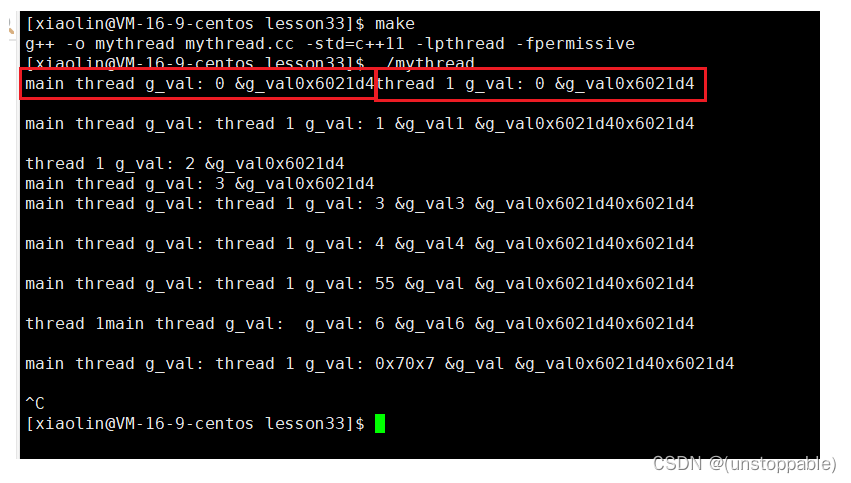
我们看到g_val被大家所共享,大家都可以看到g_val,一个线程对其进程改变,其它线程都看的到。
那么如果线程想要自己是私有的变量呢?该如何?
只要在变量前加__thread即可。
代码:
#include <iostream>
#include <pthread.h>
#include <unistd.h>
#include <cstdio>
__thread int g_val = 0;
void *threadRoutine(void *arg)
{
while(true)
{
std::cout << (char*)arg << ": "<< g_val << " &: " << &g_val << std::endl;
g_val++;
sleep(1);
}
}
int main()
{
pthread_t tid;
pthread_create(&tid, nullptr, threadRoutine, (void *)"thread 1");
while(true)
{
std::cout << "main thread: " << g_val << " &: " << &g_val << std::endl;
sleep(1);
}
return 0;
}
运行代码:
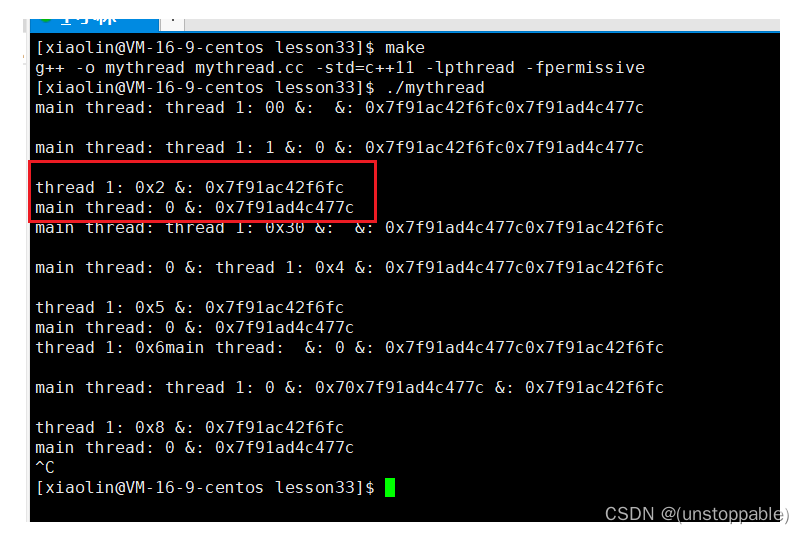
这里运行的时候是并行执行的所以会看不清,但是我们也能看到,两个变量的地址不一样的。
__thread:修饰全局变量,带来的结果就是让每一个线程各自拥有一个全局变量---->线程的就不存储。
我们之前学过进程替换,如果线程进行进程替换会如何?
代码:
#include <iostream>
#include <pthread.h>
#include <unistd.h>
#include <cstdio>
__thread int g_val = 0;
void *threadRoutine(void *arg)
{
execl("/bin/ls","ls",nullptr);
while(true)
{
std::cout << (char*)arg << ": "<< g_val << " &: " << &g_val << std::endl;
g_val++;
sleep(1);
}
}
int main()
{
pthread_t tid;
pthread_create(&tid, nullptr, threadRoutine, (void *)"thread 1");
while(true)
{
std::cout << "main thread: " << g_val << " &: " << &g_val << std::endl;
sleep(1);
}
return 0;
}
运行结果:

我们看到ls确实被执行了,但是整个进程的代码都被替换掉了。
分离线程
默认情况下,新创建的线程是joinable的,线程退出后,需要对其进行pthread_join操作,否则无法释放资源,从而造成系统泄漏。
如果不关心线程的返回值,join是一种负担,这个时候,我们可以告诉系统,当线程退出时,自动释放线程资源。
测试代码:
#include <iostream>
#include <pthread.h>
#include <unistd.h>
#include <cstdio>
#include <cerrno>
#include <cstring>
__thread int g_val = 0;
void *threadRoutine(void *arg)
{
pthread_detach(pthread_self());
while(true)
{
std::cout << (char*)arg << ": "<< g_val << " &: " << &g_val << std::endl;
g_val++;
sleep(1);
}
}
int main()
{
pthread_t tid;
pthread_create(&tid, nullptr, threadRoutine, (void *)"thread 1");
while(true)
{
std::cout << "main thread: " << g_val << " &: " << &g_val << std::endl;
sleep(1);
break;
}
int n = pthread_join(tid,nullptr);
std::cout << "n:" << n << " errstring: " << strerror(n) << std::endl;
return 0;
}
运行结果:

我们看到join异常进程直接退出。
所以线程分离后线程异常也会影响整个进程
C++语言提供的线程,而语言级别的线程库必须调用原生线程库---->本质是对原生线程库的封装
代码:

运行:
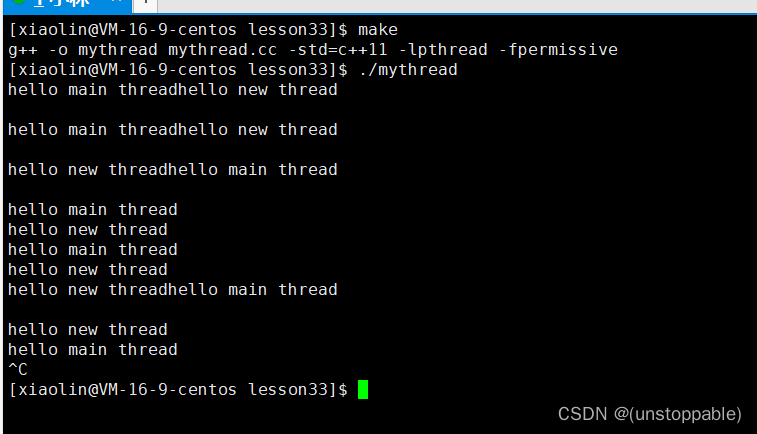
进程线程间的互斥相关背景概念
临界资源:多线程执行流共享的资源就叫做临界资源
临界区:每个线程内部,访问临界自娱的代码,就叫做临界区
互斥:任何时刻,互斥保证有且只有一个执行流进入临界区,访问临界资源,通常对临界资源起保护作用
原子性(后面讨论如何实现):不会被任何调度机制打断的操作,该操作只有两态,要么完成,要么未完成
如果多个线程访问同一个全局变量,并对它进行数据计算,多线程会互相影响吗?
测试代码:
抢票代码
#include <iostream>
#include <thread>
#include <pthread.h>
#include <unistd.h>
#include <cstdio>
#include <cerrno>
#include <cstring>
int tickets = 10000;
void *GetTickets(void *args)
{
while (true)
{
if (tickets > 0)
{
usleep(1000);
printf("%p : %d\n", pthread_self(), tickets);
tickets--;
}
else
{
break;
}
}
return nullptr;
}
int main()
{
pthread_t t1;
pthread_t t2;
pthread_t t3;
pthread_create(&t1, nullptr, GetTickets, nullptr);
pthread_create(&t2, nullptr, GetTickets, nullptr);
pthread_create(&t3, nullptr, GetTickets, nullptr);
pthread_join(t1, nullptr);
pthread_join(t2, nullptr);
pthread_join(t3, nullptr);
return 0;
}
运行结果:
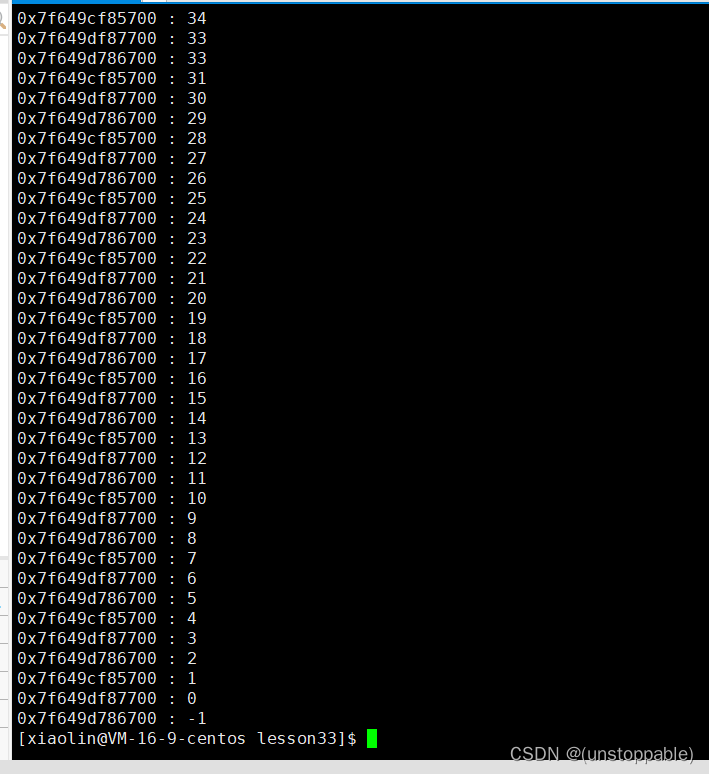
我们发现票抢到-1了,这肯定是错的!
每次运行的结果都不一定一样:
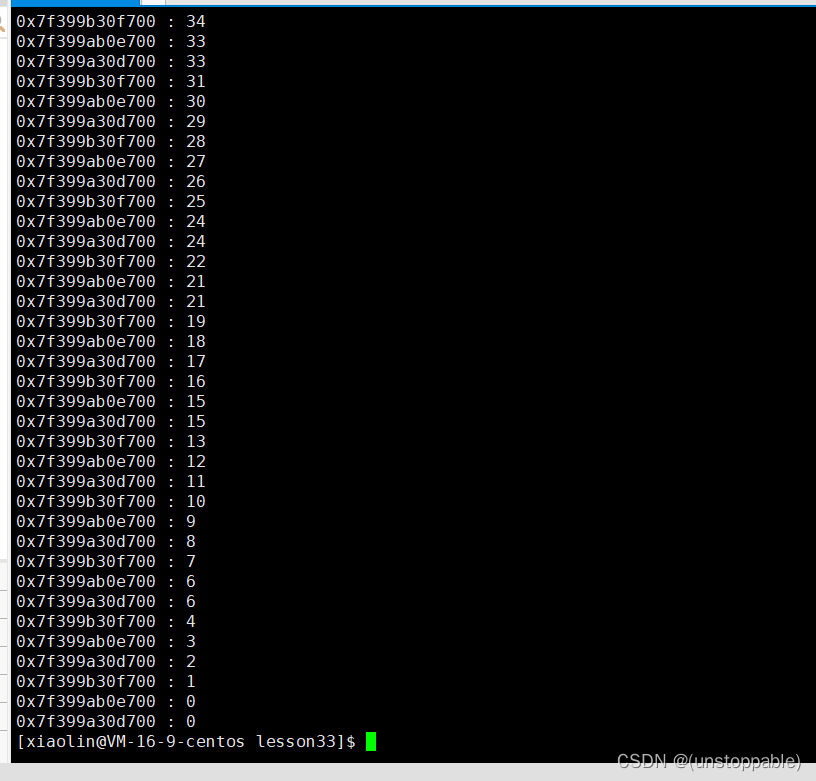
所以tickets在并发访问的时候,导致了我们数据不一致的问题。之后再解决这个歌问题。
